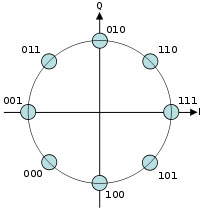Communication - Specifications (page 3 of 11)
Communication link
Forward Error Correction Coding:
Every eight hours, about 17Mbits needs to be transmitted. Employing the most powerful forward error correction (FEC) codes – Turbo Codes, the data will be error corrected prior to modulation. In order to achieve a median between error correction efficiency and data size, rate ¾ Turbo codes are employed. Thus, the error corrected data size is
17Mbits*(4/3) = 23Mbits.
Modulation & Bandwidth:
Since all wireless transmission needs to be in analog, the data is modulated using Phase Shift Keying (PSK). PSK modulation eliminates distortion due to non-linearity of the amplifiers. 8-PSK is employed to increase the bandwidth efficiency. Higher orders than 8-PSK is seldom used because, 1) the phase increment is too small, and 2) the phase noise becomes the limiting factor.

Constellation Diagram of 8-PSK [Wikipedia.com]
With
8PSK and ¾ Turbo coding, the bit error rate (BER) is estimated around 1e-7 for
Eb/N0 greater than 7dB. [http://www.satsig.net/symbol01.htm]
A
bandwidth of 80 kHz is chosen since the data transmission to the Orbiter can
now be completed in 135s and the low bandwidth enables a good signal to noise
ratio (SNR).
Frequency
of transmission:
In the communication
link between the surface of Venus and the Orbiter, the radiated RF signals have
to travel through about 50km of CO2 and SO2.

